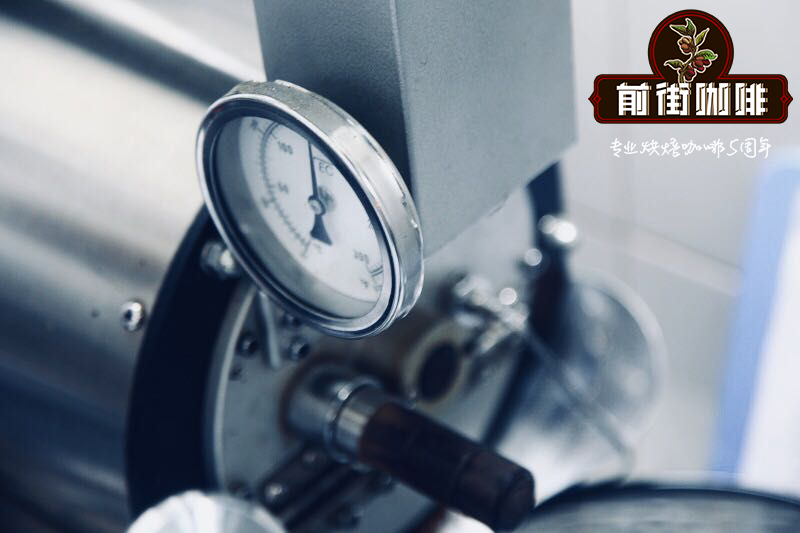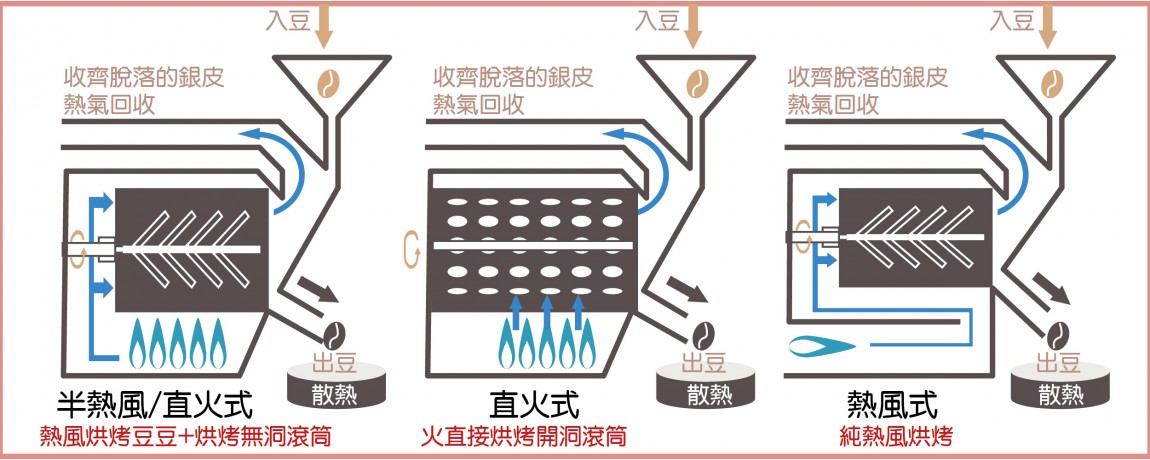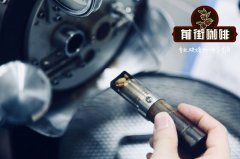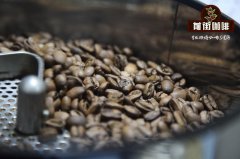Common methods of roasting coffee beans the best type of coffee roaster is.

Professional coffee knowledge exchange more coffee bean information please follow the coffee workshop (Wechat official account cafe_style)
Coffee bean roaster brand _ coffee bean roaster price _ coffee bean roaster guide
So what is the importance of baking? Among the factors that affect the taste of a cup of coffee
Raw beans account for 60%, baking for 30%, and extraction for 10%.
Good baking can maximize the personality of raw beans and minimize the occurrence of defective taste, while improper baking will completely destroy good beans. As the heating, time, and temperature control in the baking process is very difficult to grasp, baking technology is a very complex technology, so the importance of baking is more prominent.
The coffee is cold.
Cooling coffee
What is baking? What is the definition of baking?
Generally speaking, the so-called coffee bean roasting (coffee roasting) refers to the heating of raw beans to promote a series of physical and chemical reactions inside and outside the coffee beans. When coffee beans are roasted, the volume of coffee beans expands and is 1/3 larger than that of raw beans. How to perfectly show the characteristics and flavor of coffee is the most important key, so how to bake is a technology, but also an art. Because of the different depth of roasting, the coffee beans have different personality and flavor.
And in this process, the formation of sour, bitter, sweet and other flavors of coffee, the formation of mellow and tone, the process of converting raw beans into dark brown beans. There are many ways to bake, and the baking depth of coffee beans
It can be divided into three types: shallow baking, medium baking and deep baking.
The consistent goal is a series of chemical reactions to transfer heat to coffee beans.
In the early days, people generally used iron pot to stir-fry coffee beans. after coffee was introduced into Europe, Europeans used Turkish iron pot to stir-fry beans, and later invented hand-operated rotary baking, which could bake several pounds of beans at the same time, which was used by some coffee shops.
1860's: large roasters began to come out.
At the end of the 19th century, the advent of hot air roaster greatly improved the speed and efficiency of coffee roasting.
Makes it possible to produce more in large quantities.
20th century: the combination of roaster and electronic, has been improved to be more sophisticated, the emergence of fully automatic roaster
And has more advanced functions.
There are three major difficulties that coffee beans often face when roasting:
one. External environmental impact: air temperature, air pressure, humidity. Etc.
two. Coffee bean characteristics: water content, bean seed, bean quantity. Etc.
three. Types of baking machines: direct fire, semi-direct fire, hot air
Common types of coffee bean roaster

1. hot air type
The hot air type bean dryer uses a blower to suck in air, and then let the air pass through a heating coil to raise its temperature. The hot air is used as a heating source to roast coffee beans. The hot air can not only provide the temperature required for roasting, but also use the power of the airflow to stir the coffee beans.
★ advantages : High thermal efficiency, fast heating, raw beans heated more evenly, easy to control.
★ disadvantages : Because the heating efficiency is high, it is easy to cause the temperature to rise too fast, causing the beans to be "sandwiched", and the temperature is too high. Which makes the caramelization reaction insufficient.
* (uncooked meaning: not ripe)
★ Taste characteristics: acidity is obvious, taste is relatively clean and simple, but the richness of taste is not enough and lacks depth, and
Deep baking tends to produce pungent flavors.
2. direct fire
As the name suggests, direct fire is the direct heating of coffee beans with a flame. Evolution so far, the "fire" of direct fire in addition to the general flame (including gas fire and charcoal fire), but also includes infrared rays and electric heating tube.
Put the green beans into a perforated drum and heat them directly with the fire of a gas burner.
★ Advantages: Baking time is longer, so that the caramelization reaction is more complete and the taste is richer.
★ Disadvantages: It is easy to cause uneven baking, and if the temperature is not well controlled, it is easy to burn coffee beans and form a bitter taste.
3. semi-direct fire semi-hot air type
The drum is coated with iron plate, and hot air is sent from the rear of the drum, so that the beans do not directly contact the baking fire.
For the mainstream of commercial baking machines at present, similar to direct fire baking, because there are no holes on the outer wall of the baking container, the flame
No direct contact with coffee beans; ventilation equipment, hot air outside the roasting container into the roasting chamber to improve roasting efficiency.
"Another function of the exhaust system is to extract the detached silver skin (the film attached to the outer layer of coffee seeds) and prevent the silver skin from falling off.
In the baking chamber because of the high temperature combustion affects the taste. "
★ Advantages and disadvantages of both direct fire and hot air
According to the adjustment of hot air and boiler speed to change its heating mode.
The larger the hot air is opened, the faster the rotation speed is, the closer it is to the hot air type; otherwise, the closer it is to the direct fire type.
Coffee beans roasting degree
When judging the roasting degree of coffee beans, the roasting degree can be judged by sound, color and aroma.
Its color from light yellow to dark brown, aroma from elegant gradually rich; sound is issued twice burst sound.
Take high temperature resistant raw beans as an example, the first explosion starts at about 7 minutes and lasts for about 2 minutes. The sound is low, indicating the beginning.
Pyrolysis, starch conversion to caramel, water evaporation, exhaust, the 12th minute or so issued a second explosion, the sound is fierce and sharp, indicating that the cell fiber is broken, the deeper the baking.
Reactions and changes that occur during baking:
One explosion, two explosions-01
1. drying
When the green beans are heated, the water vapor in the green beans will evaporate at about 135℃, and the green beans will start to turn white.
2. dehydration
With heating, green beans turn pale yellow, and when the temperature reaches about 160℃-175℃, they will emit baking.
Grain aromas, heat continued, beans turn light brown.
3. exploded
After dehydration is completed at about 190℃-205℃, the cell wall ruptures due to internal thermal expansion to form a "explosion".
At this time, a series of thermal decomposition reactions occur inside the beans, and the appearance of the beans is also 40% to 60% larger than the original beans. The change in color of the beans is also noticeable, from pale yellow to khaki to darker browns.
The compounds in the beans undergo hydrolysis to produce water-soluble polysaccharides. As the reaction continues, these polysaccharides will begin
Caramelization, which gives coffee beans their sweetness and brown color, is also the main cause of coffee aroma. when other
Carbohydrates continue to break down into volatile acids. Among them, the key to coffee taste-chlorogenic acid is coffee.
The main cause of astringency and consistency is that it decreases proportionally with the degree of baking and inversely with the baking speed. Therefore, if the roasting speed is too fast, it is easy to make coffee with astringency.
4. secondary explosion
As the heating progresses, the beans become more brittle because they have been dehydrated, and the pressure inside the cells continues to rise,
About 225℃-230℃, into the "second explosion", at this time the wood structure inside the beans split, will occur more intense
Reacts, and releases a lot of heat. With the end of the second explosion, the green beans have basically turned black, and the beans have expanded to
The original 1.5 times, surface oil, weight reduced to 12%---20%.
If the baking process continues beyond the second baking, the initial caramelization and starch will begin to carbonize and present
And the charring characteristics of deep baking.
5. stop
Usually at the latest after the end of the second explosion about a minute when the temperature reached 240℃-245℃ to end baking, then will be a deeper French or Italian baking. Continued heating above 230 degrees may cause coffee beans to spontaneously combust.
To stop baking with plenty of cold air or water. Water will work faster than air. But if you stop it with water,
Roasting, water is the key point, must be moderate in quantity, so as not to cause the beans to absorb water.
To subdivide the timing of the explosion:
Burst Sound Degree Table-01
Coffee Roasting Degree and Timing of Beans
Coffee beans contain sour ingredients such as citric acid, malic acid, quinic acid, phosphoric acid, etc., but this is not the sour taste we feel when drinking coffee. The sourness we taste comes mainly from the acid produced during baking.
The well-known coffee roasting degree is mainly divided into the following four degrees:
1. Light baking 2. Medium baking 3. Deep baking
high acidity → Low acidity (bitter)
Each level can be subdivided into two, a total of eight stages.
Baking Degree-01
The acidity of coffee can also be defined by technology, that is, the so-called PH value (that is, pH value)!
Light roast breakfast coffee →PH between 4.5 and-4.7
Medium Deep Baked (Full City) PH is around 5- 5.5.
Dark Roast →PH above 5.5
These factors are directly and indirectly related to roasting coffee beans. If you handle them carefully, you can use them properly to achieve your expectations. So, it is not enough to know the coffee roasting organization and know the roasting process!!! What kind of coffee bean roaster is on the market? Some people are using it. The effect is different. Why is this so? It is not enough to understand the baking mechanism used by themselves, caused by the principle of operation.
Diedrich Roaster Coffee Roaster Infrared Roasting Technology
Important Notice :
前街咖啡 FrontStreet Coffee has moved to new addredd:
FrontStreet Coffee Address: 315,Donghua East Road,GuangZhou
Tel:020 38364473
- Prev

Common coffee beans roaster types and roaster brands introduced from home coffee roasters recommended
Professional coffee knowledge exchange More coffee bean information Please pay attention to coffee workshop (Weixin Official Accounts cafe_style) coffee bean roaster brand_coffee bean roaster price_coffee bean roaster shopping guide In the factors affecting the taste of a cup of coffee, raw beans account for 60%, roasting accounts for 30%, extraction accounts for 10%, good roasting can bring the personality of raw beans to the extreme and minimize defects
- Next

The Mechanism and Environment of Coffee roasting explain the detailed steps of coffee bean roaster
Professional coffee knowledge exchange more coffee bean information please follow coffee workshop (Wechat official account cafe_style) coffee bean roaster brand _ coffee bean roaster price _ coffee bean roaster recently installed a monitoring device on the coffee bean roaster-air temperature with this equipment can observe more coffee roasting response mechanism and control environment first roast coffee
Related
- What is the Philharmonic pressure? How to use Philharmonic pressure to make delicious coffee
- Why does a hand grinder have more fine powder than an electric grinder?
- In addition to the hot mom, what is the difference between the versions of EK43 | ditting and Mahdi ek43?
- What kind of equipment do you need to make coffee by hand? Introduction to novice starter cooking equipment tools
- Espresso needs to be ground how thick and thin scale entry Italian Coffee Machine Bean Grinder investigation and Grinding course
- How much does it cost to open a small private cafe? How much does it cost to learn coffee? How to operate it?
- The difference between the flavor characteristics of hand-brewed coffee and coffee maker is hand-brewed coffee really better than coffee maker? Can I use a coffee machine to make coffee beans by hand?
- The difference between 01 and 02 of hario v60 filter cup what is the difference between 01 and 02 filter cup opening and cooking flavor
- What's the difference between the smart cup and the French kettle? Which is better, the French kettle or the Smart Cup?
- What's the difference between a smart cup and a V60 filter cup? The difference between the taste of smart cup and hand-brewed coffee

